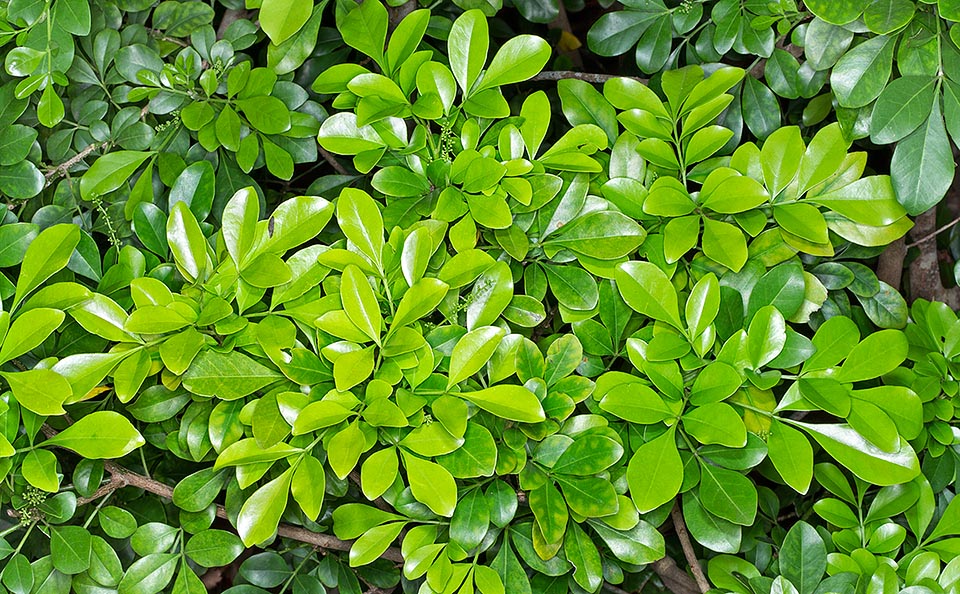Family : Meliaceae

Text © Pietro Puccio

English translation by Mario Beltramini
The species is native to Cambodia, China (Guangdong, Guangxi and Hainan), Laos, Myanmar, Thailand and Vietnam where it lives in the sparse forests and wet scrublands often on clayey soils.
The name of the genus comes from the Greek “ἀγλαΐα” (aglaia) = splendour, magnificence, that is also the name of one of the Charites, divinieties in Greek mythology; the specific name is the Latin adjective “odoratus, a, um” = odorous, scented, with reference to the flowers.
Common names: Chinese perfume tree, Chinese rice flower, mock lemon (English); trayang (Khmer); mi zi lan, shu lan, xian huo lua, yu chu lan (Chinese); pacar cina (Indonesian); khai pou (Lao); murta-do-campo, agláia (Portuguese-Brazil); cinamomo de China, falsa lima (Spanish); sinamomong-sungsong (Tagalog); homklai, khayong, prayong (Thai); ngau tau, boa ngu (Vietnamese).
The Aglaia odorata Lour. (1790) is a shrub or a small evergreen dioecious tree, very ramified, 2-6 m tall, with greyish bark tending to fissure with the age. The leaves are alternate, imparipinnate, 5-14 cm long, with 3-7 obovate-oblong leaflets with obtuse apex and entire margin, 2-7 cm long and 0,5-4 cm broad, with slightly winged petiole and rachis, of intense green colour and glossy. Axillar panicle inflorescences, 5-12 cm long, carrying numerous tiny globose flowers, of 2-3 mm of diameter, of yellow colour, delicately scented.
The fruits, obviously in the female plants in presence of male ones, are ovoid berries of about 1 cm of length and 0,7 cm of diameter, of orange or red colour containing usually only one seed provided of fleshy aril.
It usually reproduces by semi-woody cutting and air layering, less by seed, rarely produced, also because in cultivation are preferred the male plants due to the more intense scent of the flowers.

Aglaia odorata is a dioecious shrub, even 6 m high, often cultivated in the tropical gardens. It bears drastic prunings for thick hedges or topiary art oddities, but is also a medicinal plant. Extracts from its branches and leaves have insecticide and herbicide virtues and the tiny scented flowers are locally dried in order to flavour the tea © Giuseppe Mazza
Species with particularly slow growth and almost continuous blooming, cultivable in the tropical, subtropical and marginally warm temperate, climate zones, where adult specimens may bear temperatures around the 0 °C, if exceptional and short lasting. It requires well drained soils, slightly acidic to neutral, maintained almost constantly humid, but without stagnations, and an exposition in full sun or slightly shaded; ideal for hedges and topiary art, bearing well the prunings, even if drastic.
Of easy cultivation, it well adapts to the cultivation in pot, preferably of clay in order to foster the airflow in the roots, for the decoration of inner spaces in luminous position, such as a window facing east or west, even if it can bear less luminous situations, and does not require high ambient humidity, with lowest night temperatures preferably not under the 15 °C. The waterings must be regular, but allowing the substratum to dry up almost completely before watering again, with beweekly fertilizations, during the growing time, done with hydrosoluble balanced products with microelements in the form of chelates, at half the dosage suggested on the package.
Roots, flowers and leaves are utilized in the traditional medicine of various populations of South-East Asia for several pathologies, in particular as antipyretic and anti-inflammatory; extracts from the branches and leaves have shown interesting insecticide and herbicide properties. In China, the dried flowers are used for aromatizing the tea.
Synonyms: Camunium chinense Roxb. (1824); Opilia odorata (Lour.) Spreng. (1824); Aglaia pentaphylla Kurz (1868); Aglaia odorata var. microphyllina C.DC. (1878); Aglaia chaudocensis Pierre (1897); Aglaia duperreana Pierre (1897); Aglaia sinensis Pierre (1895); Aglaia repoeuensis Pierre (1897); Aglaia odorata var. chaudocensis (Pierre) Pellegr. (1911); Aglaia oblanceolata Craib (1926).
→ To appreciate the biodiversity within the MELIACEAE family please click here.
